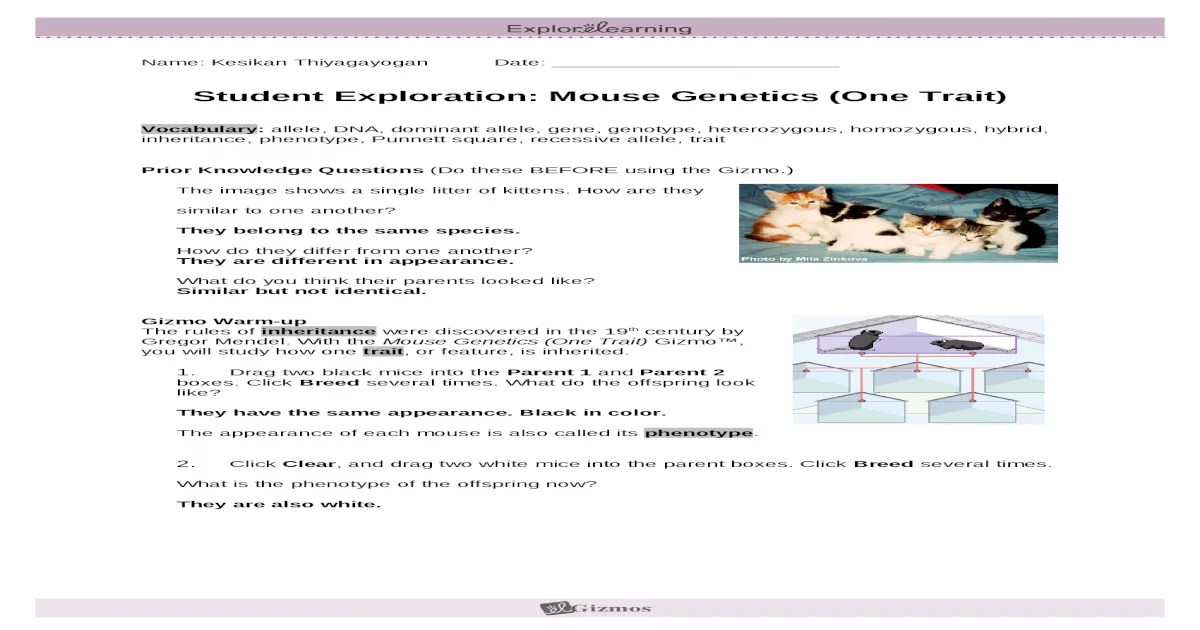Mouse Genetics Gizmo One Trait Answer Key unlocks the fascinating world of genetics, providing a comprehensive guide to the Gizmo simulation and the fundamental concepts that govern the inheritance of traits. This key serves as an indispensable resource for students and educators alike, offering a step-by-step approach to conducting experiments, analyzing data, and understanding the principles of Mendelian inheritance.
Delving into the intricacies of mouse genetics, this key illuminates the role of alleles, genotypes, and phenotypes in shaping the characteristics of organisms. It explores the principles of probability and statistics in genetics, empowering readers to interpret experimental results with precision.
Moreover, the key highlights the applications of mouse genetics research in medicine and agriculture, showcasing the profound impact of this field on our understanding of human health and agricultural practices.
Mouse Genetics Gizmo: One Trait
Mouse Genetics Gizmo: One Trait is a virtual simulation that allows students to explore the inheritance of a single gene in mice. The purpose of the experiment is to demonstrate the principles of Mendelian inheritance and to show how different alleles of a gene can affect the phenotype of an organism.
The variables involved in the experiment are the genotype of the parents, the genotype of the offspring, and the phenotype of the offspring.
Genetics Concepts
Allele: An allele is one of two or more alternative forms of a gene that occur at a specific position on a chromosome. Each gene has two alleles, one inherited from each parent.
Genotype: The genotype of an organism is the combination of alleles that it has for a particular gene. For example, an organism that has two copies of the same allele for a gene is said to be homozygous for that gene.
An organism that has two different alleles for a gene is said to be heterozygous for that gene.
Phenotype: The phenotype of an organism is the observable characteristics of the organism. The phenotype of an organism is determined by its genotype and by the environment in which it lives.
Mendelian inheritance: Mendelian inheritance is the study of how traits are passed down from parents to offspring. According to Mendelian inheritance, each parent contributes one allele for each gene to their offspring. The offspring’s genotype is the combination of the two alleles that they inherit from their parents.
Probability in genetics: Probability is used in genetics to predict the likelihood of inheriting a particular genotype or phenotype. For example, if a parent is heterozygous for a gene, there is a 50% chance that their offspring will inherit the dominant allele and a 50% chance that they will inherit the recessive allele.
Experimental Procedure
To conduct the “One Trait” experiment in the Gizmo, follow these steps:
- Select the “One Trait” experiment from the Gizmo menu.
- Choose the type of trait that you want to study. You can choose from fur color, eye color, or tail length.
- Set the genotype of the parents. You can choose from homozygous dominant, homozygous recessive, or heterozygous.
- Run the simulation. The Gizmo will simulate the breeding of the parents and the inheritance of the trait in the offspring.
- Collect data on the genotype and phenotype of the offspring.
Data Analysis
To analyze the data from the “One Trait” experiment, you can create a data table to record the genotype and phenotype of the offspring. You can then use the data table to determine the inheritance pattern of the trait.
For example, if you are studying fur color, you might find that the offspring of two black mice are all black. This would suggest that the black fur color allele is dominant to the white fur color allele.
You can also use statistics to interpret the results of the experiment. For example, you can use a chi-square test to determine if the observed inheritance pattern is consistent with the expected inheritance pattern.
Applications of Mouse Genetics: Mouse Genetics Gizmo One Trait Answer Key

Mouse genetics research has contributed to our understanding of human genetics in a number of ways. For example, mouse models have been used to study the genetic basis of diseases such as cancer, heart disease, and diabetes.
Mouse genetics research has also led to the development of new treatments for human diseases. For example, the drug Gleevec was developed to treat chronic myeloid leukemia. Gleevec targets a specific protein that is overexpressed in chronic myeloid leukemia cells.
The discovery of this protein was made possible by research on mice.
Mouse genetics research has also been used to improve agricultural practices. For example, mouse models have been used to study the genetic basis of traits such as growth rate, feed efficiency, and disease resistance. This research has led to the development of new breeds of mice that are more productive and resistant to disease.
Key Questions Answered
What is the purpose of the “One Trait” experiment in the Gizmo simulation?
The “One Trait” experiment allows students to simulate the inheritance of a single trait in mice, enabling them to observe the patterns of inheritance and explore the principles of Mendelian genetics.
How do I determine the inheritance pattern of a trait using the Gizmo?
By analyzing the data collected from the Gizmo simulation, students can identify the inheritance pattern of a trait by observing the proportions of different genotypes and phenotypes in the offspring.
What are the potential applications of mouse genetics research in medicine?
Mouse genetics research has contributed to our understanding of human genetics and has led to the development of treatments for genetic diseases, such as cystic fibrosis and sickle cell anemia.